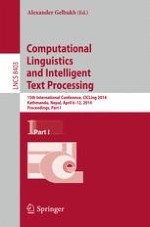This two-volume set, consisting of LNCS 8403 and LNCS 8404, constitutes the thoroughly refereed proceedings of the 14th International Conference on Intelligent Text Processing and Computational Linguistics, CICLing 2014, held in Kathmandu, Nepal, in April 2014. The 85 revised papers presented together with 4 invited papers were carefully reviewed and selected from 300 submissions. The papers are organized in the following topical sections: lexical resources; document representation; morphology, POS-tagging, and named entity recognition; syntax and parsing; anaphora resolution; recognizing textual entailment; semantics and discourse; natural language generation; sentiment analysis and emotion recognition; opinion mining and social networks; machine translation and multilingualism; information retrieval; text classification and clustering; text summarization; plagiarism detection; style and spelling checking; speech processing; and applications.
